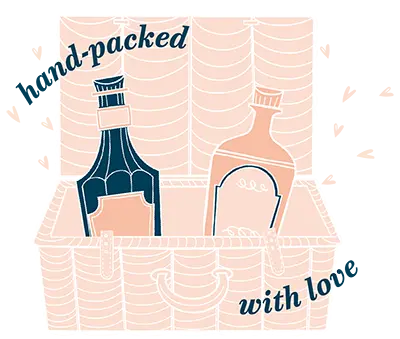Whether you’re a first-time drinker or long-time admirer, there is a gin for every occasion and this helpful handbook hopes to help guide you towards the right one for your taste palate.
Gin is a drink that has absolutely soared in popularity over the past few years and for many it has been the perfect tonic to see them through the lockdown period, pun definitely intended! There were reportedly a monumental 73 million bottles of gin purchased by consumers in the UK in 2018 - and that was just for our staff Christmas party. Affectionately known as the ‘ginassaince’, the spirit has transformed from a drink you might enjoy with your parents every now and again, to the most popular tipple in bars and households across the country.
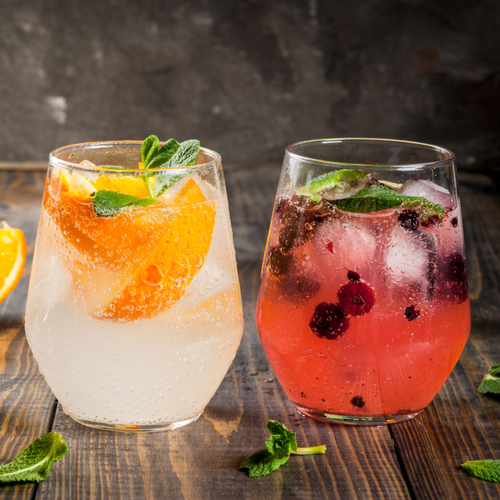
What is gin?
But what exactly is gin and what is it made from? Gin is actually very similar to vodka, in that they both begin with a neutral spirit of 96% ABV (alcohol by volume) that has been derived from grain, or another similar agricultural source. The difference with gin is that it is compounded with a plethora of different botanicals, or flavours, with the most prominent being the juniper berry. Fun fact for you – gin is believed to originate from the Dutch spirit ‘genever’, from which the phrase ‘Dutch courage’ was allegedly born.
How many types of gin are there?
There are four distinct types of gin. As with most things you could spend all day naming hundreds of different categories, but the four most recognised are London Dry, Plymouth, Old Tom and Genever (with ‘International Style’ sometimes acknowledged as an optional fifth).
London Dry gin is the most commonly regarded, and the kind that you will find in most G&Ts and martinis. Despite the name, it can be found in bars all over the world. You will find that these are aptly named as dry, but also aromatic, with a strong and distinctive juniper flavours coming through. The Berkshire Botanical Dry Gin is a prime example; crisp and delicate, distilled with hand-picked botanicals including juniper, grapefruit, sweet orange peel and Norway spruce. This can be found in The Luxury Gin Hamper, where it’s been expertly paired with Fentimans tonic and complimentary tastes, including delicious handmade fudge and gourmet popcorn.
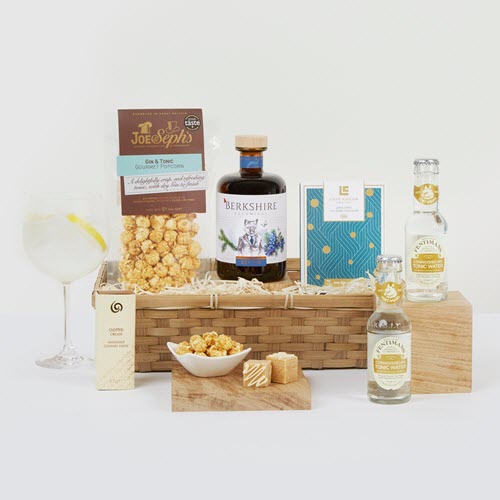
Plymouth, while a distinct type of gin, can only be produced in one distillery – one of the oldest in the UK at that. Any guesses as to where? In terms of its flavour, it’s noticeably drier than London gin, with a spicier finish and more citrus-focused taste.
‘Old Tom’ was the street name given for homemade, artificially sweetened gin in the 18th Century, which now represents those richer in flavour than London Dry, with citrusy sweetness and malty tones, used commonly in prohibition-era cocktails, like Tom Collins.
Last but not least comes Genever, the original style of gin, which has an even richer flavour than Old Tom; they are not so strongly flavoured with juniper and botanicals, so you likely won’t taste citrus at all with this style.
What to drink with gin?
Now that we have covered the origins, we can move on to more important things – like how to drink it.
There are hundreds of different combinations of gin drinks you can try out, so we’re going to share with you some of our favourites. As this post is in honour of its very own day, let’s start with tonic: the classic, undisputed champion of gin mixers and the perfect accompaniment to a London Dry. The vibrant and aromatic flavour of the gin is perfectly balanced by the bitterness of the quinine in tonic, resulting in a drink of bittersweet, zesty perfection. Included in each gin gift set on our site is tonic for a mixer, because we know better than to mess with a true classic.
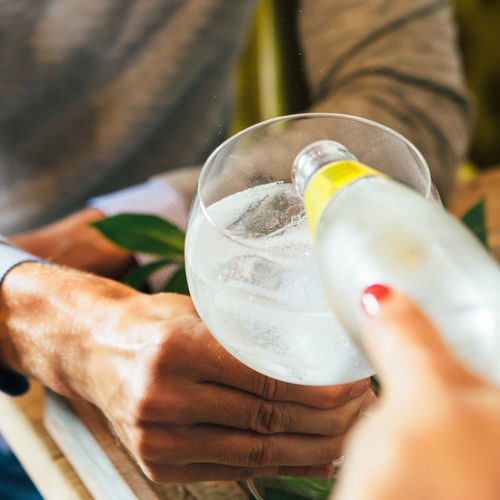
The first rule of gin and tonic is that it’s pointless without some ice and it’s recommended that you let the ice cool the drink down for a short while before taking your first sip. Not only should you have ice in your gin and tonic, but you should ensure that the mixer is chilled before creating your cocktail. As for garnish, you can’t go wrong with a wedge of lemon or lime or even some cucumber slices, but for those feeling a bit more adventurous a sprig of mint or some ginger will do just the trick.
You should always try to match flavours when picking which gin to go with which tonic and there is such a surprising array of different flavours that you can create from a simple mix. For example, consider adding some extra fruit, flavour and colours to the drink by opting for a pink gin, which are infused with things like strawberries, raspberries and currants. A suitably vibrant bottle of gin can be found in the Flagingo Pink Gin Hamper, which combines the fruity flavours of the Caribbean in one bottle of Flagingo, expertly matched with Fentimans tonic water and delicious sweet treats, including chocolate counters and truffles. You can find this and our other collection of brilliant options on our gin hampers page.
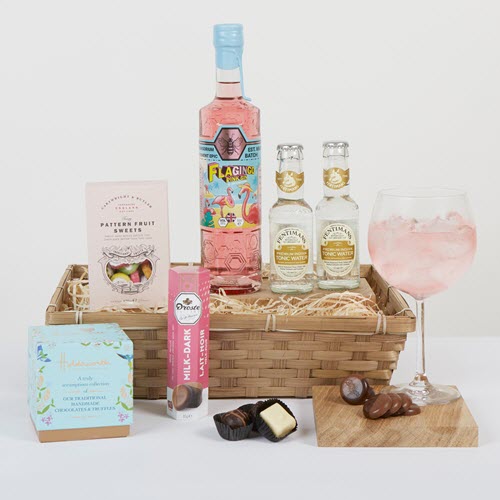
The drink has become so popular and widespread in the country that it is now sold in handy little cans, with one politician even famously photographed enjoying one on the London Underground. These cans come in all sorts of variations, such as the those found in the Gin & Treats Hamper; a delicious raspberry-infused Manchester gin, paired with a Sicilian lemon tonic, all included with hand baked biscuits, chocolates and sweets to make for the perfect gift (or night in to yourself, we won’t tell).
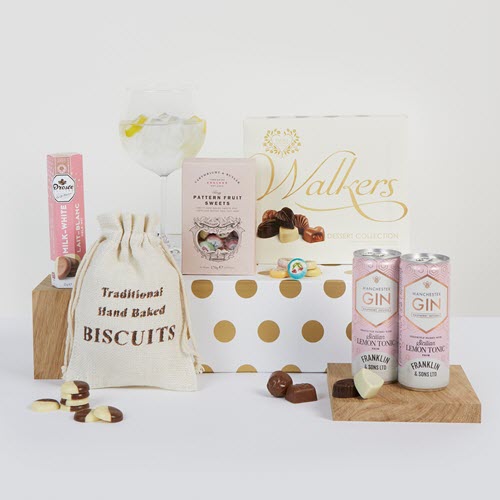
If you’re someone that likes even more flavour than a pink gin and tonic would present then you’re in luck, because you can mix gin with many different types of fruit juice for a range of versatile results. For those that prefer their flavours zesty, citrusy or bitter, lemon or lime juice makes a great accompaniment for a glass of gin, while those that prefer sweeter, tropical flavours will want to try the spirit out with pineapple juice, the alleged inspiration behind the iconic Snoop Dogg song ‘gin and juice’.
If you like bubbles in your beverage, then you have plenty of mixers to choose from outside of tonic and fruit juice. For those that like the taste of lemon but want something a bit sweeter than straight juice, gin and lemonade is a great choice and a particularly delicious one for a warm summer’s day. One drink that many find tastes great – despite grumbles from the purists – is gin and coke; while its flavours can overpower the botanicals in the liquor, pairing it with an everyday gin, a dash of orange bitter, some lime juice and ice, can make for a surprisingly refreshing drink.
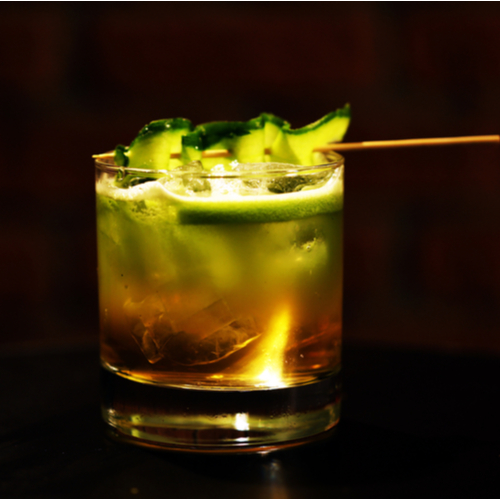
Finally, if you’re the type of person to push the boat out, then these last suggestions will be for you. While certainly not everyone’s cup of tea, gin and Earl Grey makes for a delicious mixer, with the flavours of the teabag drawing out the botanicals of the spirit. Brew a pot and allow it to cool in the fridge, before adding one part tea and three parts gin. Shaken with ice and poured into your favourite cocktail glass, and you’ll be in gin heaven!
There are plenty of wonderful gin cocktails that can be created with the versatile spirit. The classic Martini is actually made with gin rather than vodka, and all you need to make it is some dry vermouth, with olives to garnish. Another hugely popular gin cocktail is the Negroni; sweeter than a Martini it combines gin with Campari and sweet vermouth, to make a classy drink for all occasions. Another classic gin cocktail – and a drink made extremely popular during prohibition – is the Tom Collins. Slightly harder to make than the other two, this cocktail should only be made using Old Tom gin, which is then mixed with real lemon juice, sweetener and soda water.

We hope that our handy hampers.com handbook has helped you learn a bit more about gin, and now that you know the best way to enjoy it, you can go impress all your friends and relatives, and enjoy a cold glass of gin and tonic with them.







